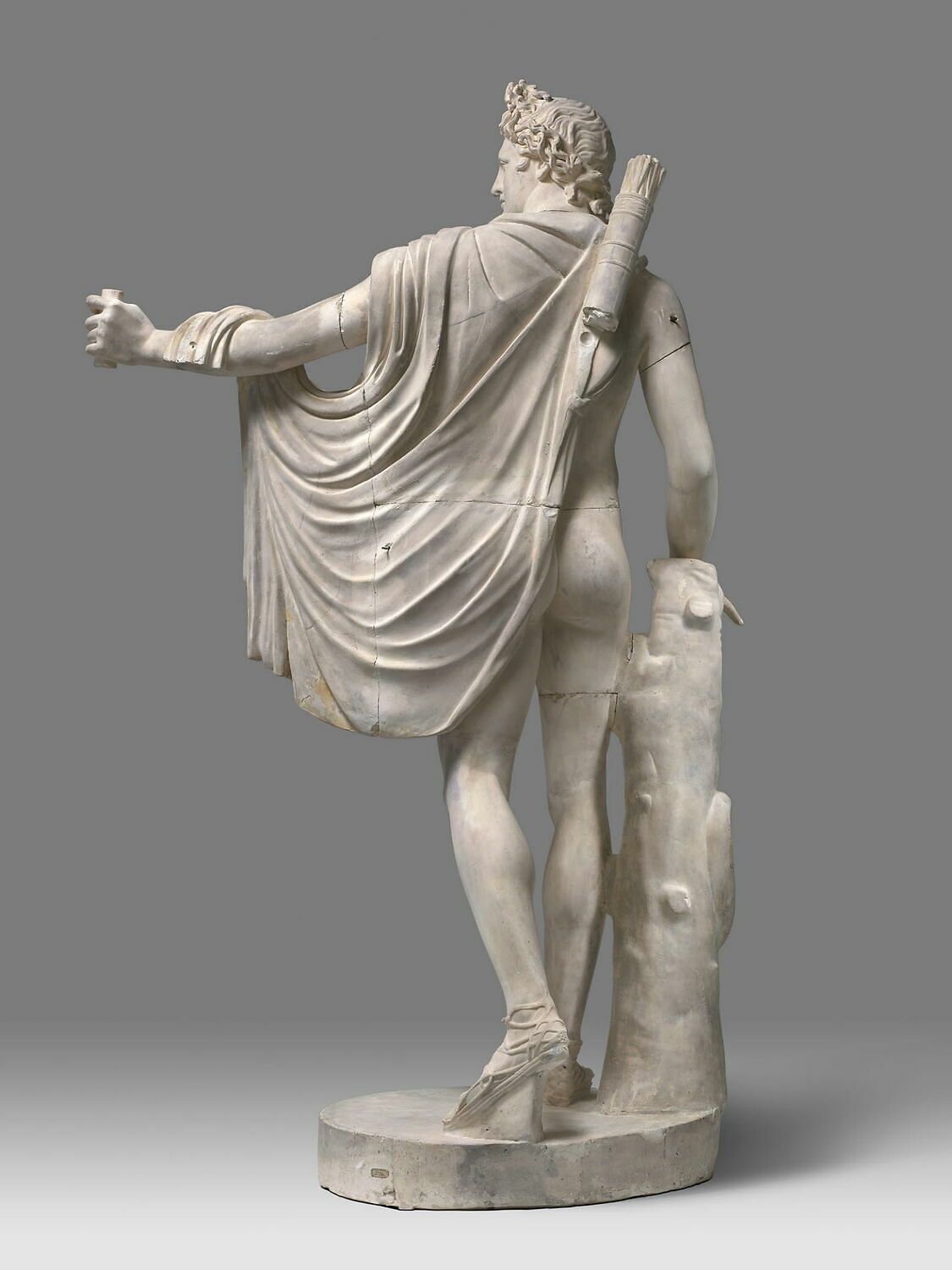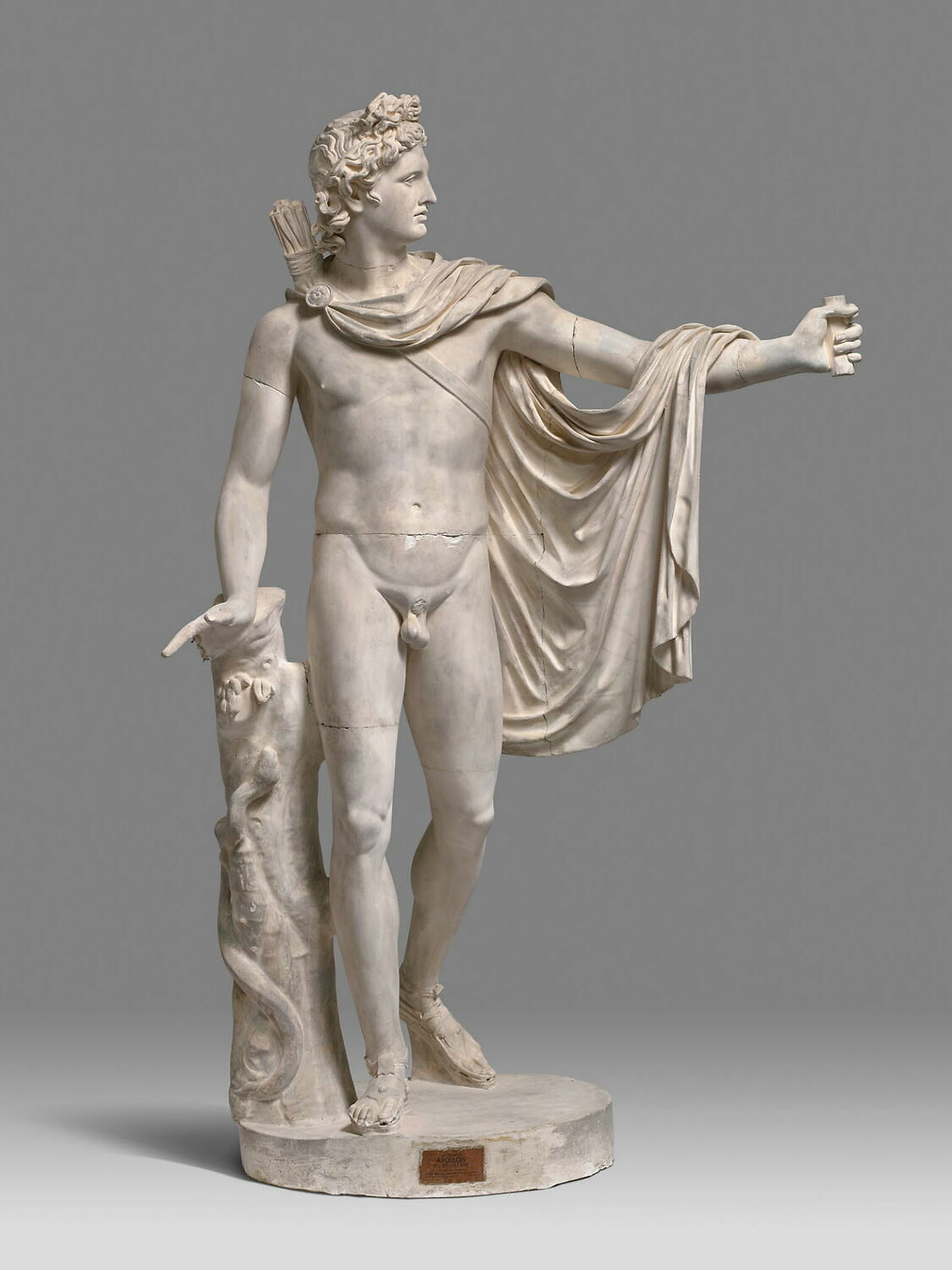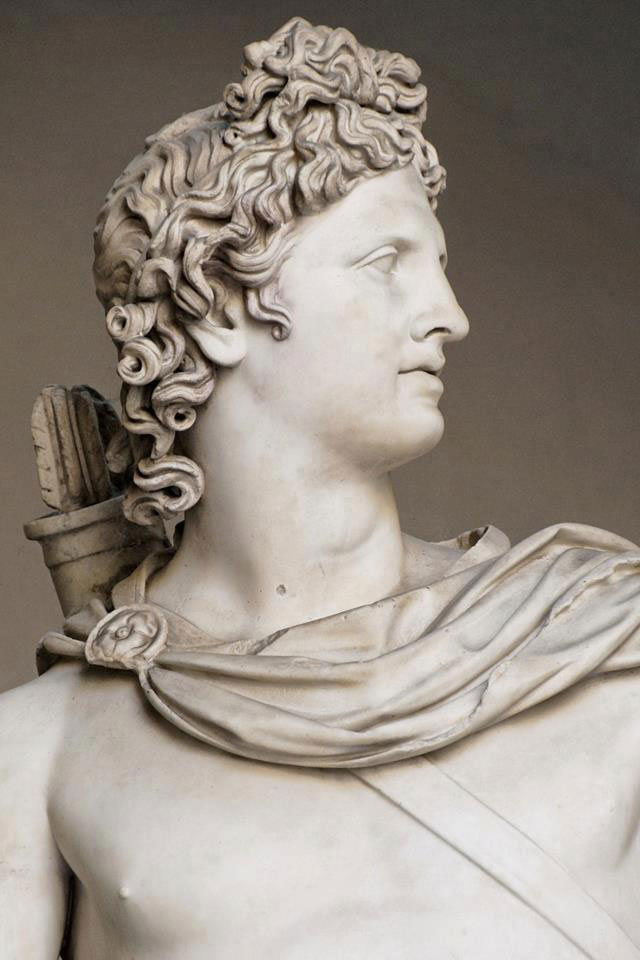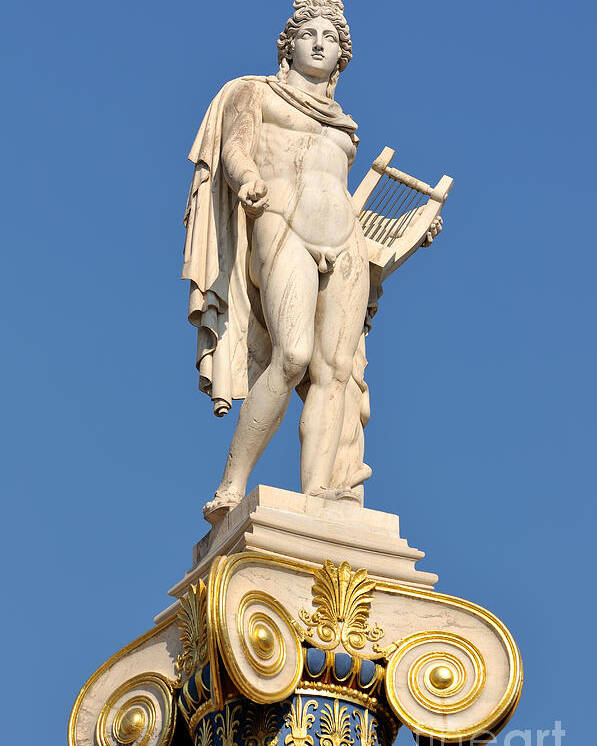
Dieu Apollon statue Dieu grec antique du soleil et de la Etsy France
The Greek god Apollo is depicted as a standing archer having just shot an arrow. Although there is no agreement as to the precise narrative detail being depicted, the conventional view has been that he has just slain the serpent Python, the chthonic serpent guarding Delphi —making the sculpture a Pythian Apollo.

Tirage intégral de l'Apollon du Belvédère Louvre Collections
Medallion representing Praxiteles. Praxiteles (/ p r æ k ˈ s ɪ t ɪ l iː z /; Greek: Πραξιτέλης) of Athens, the son of Cephisodotus the Elder, was the most renowned of the Attica sculptors of the 4th century BC. He was the first to sculpt the nude female form in a life-size statue. While no indubitably attributable sculpture by Praxiteles is extant, numerous copies of his works.

Apollo Statue Bronze 25cm/9.9'' Dieux grecs Etsy
Hauteur : 167 cm ; Largeur : 78 cm ; Epaisseur : 85 cm Materials and techniques Matériau : marbre (marbre de Paros) Technique : ronde-bosse (sculpture) Places and dates Date Epoque / période : romain impérial Date de création/fabrication : 2e quart Ie s. ap. J.-C. (époque claudienne d'après Preisshofen) (25 - 50)

Tirage intégral de l'Apollon du Belvédère Louvre Collections
Greek and Roman Art Bronze statuette of Apollo Greek ca. 500 BCE On view at The Met Fifth Avenue in Gallery 156 Apollo was a youthful god who presided over a wide variety of activities, from the initiation of boys into manhood to the utterance of oracles. His attributes were the bow and the lyre.

Apollo the Olympian Greek god of music, bronze statue made with the ancient method Hellas Art
Le Sauroctone Borghèse du Louvre Sauroctone du Vatican. Musée Pio-Clementino, galerie des statues (Inv. 750).Photographie ancienne. Apollon sauroctone, bronze du musée d'art de Cleveland. L'Apollon sauroctone est un type statuaire grec traditionnellement attribué à Praxitèle, représentant le dieu Apollon s'apprêtant à tuer un lézard, principalement connu par le Sauroctone Borghèse.

Mythologie grecque Apollon 1/4 Mythologie grecque, Apollon, Grece
Il fut particulièrement adoré à Delphes et à Délos, qui figurent parmi les sanctuaires religieux les plus célèbres du monde grec. Fils de Zeus et de Léto, et frère jumeau d' Artémis, Apollon est né sur l'île de Délos (dans la Théogonie d' Hésiode, il serra une épée d'or).

Apollo Greek God Rare bronze statue of Apollo, dated between 5th and 1st / He had the gift
Apollon du Belvédère. La statue faisait partie de la collection que le cardinal Giuliano della Rovere possédait dans son palais romain, place des Saints-Apôtres. Lorsqu'il devint pape sous le nom de Jules II (1503-1513), la sculpture fut transportée au Vatican, où elle est attestée au moins depuis 1508. Le dieu Apollon marche.

Who Was the Oracle of Delphi? (with picture)
Apollon of Olympia. The Apollon of Olympia was part of the group of sculptures found in the west pediment of the Temple of Zeus at Olympia.Its original location also provides it with another name: the Apollon from the west pediment.It is one of the most important statues of the Severe style or early Classical style, dating from ca. 460 BCE.The statue is currently in the Archaeological Museum.

13 best Classical Visual Culture images on Pinterest Sculpture, Sin city and Artworks
But the fisherman wanted to check if the statue was made of gold. So he cut off a finger and took it to a specialist. His brother cut another finger off the statue, which was destroyed by a goldsmith. Soon, members of the fisherman's family posted the Apollo statue on eBay, where they sold it for $500,000. But two days later, they withdrew the bid.

Statue Of Apollo Poster by Atsametakis
Apollon (cheveux, en bandeau, natte, frontal, ruban, chignon, nu, bras, sur, tête, appuyé, sur, tronc d'arbre : serpent, enroulé, posé, sur, base) Etat de l'oeuvre : seuls manquent l'avant-bras gauche et le sexe, restaurés en marbre peu après 1680, puis dérestaurés au milieu du XXe siècle. Un éclat sur le bas de la joue droite est bouché au plâtre.

1862 Apollo & Apollon Eu, France Extraterrestrial Locations on
Somptueuse Statue Grecque à l'effigie du dieu de la mythologie grecque, Apollon. Elle apportera une atmosphère unique à votre pièce. Livraison offerte.

Pin on Musée du Louvre, Paris Sculpture
L' Apollon citharède de Pompéi est une statue antique en bronze de 68 cm de hauteur d'origine grecque et provenant des environs de Pompéi. Datée du IIe siècle av. J.-C. ou Ier siècle av. J.-C., c'est un des rares bronzes grecs antiques parvenus jusqu'à nous.

Statue of Apollo Roma mitolojisi, Yunan mitolojisi, Statues
Hire new staffs and make the best use of location. Check the palms, the statues and the cathedral. The tourist office is located in the CorreoChile buidling. Go there and get free maps and guides for the city and for the region. There is free bus tours that depart from here - check the schedule at the tourist office as well.

Apollo Büste Statue griechischen Gott Skulptur antiken Griechenland Gott der Musik und Sonne
Apollon a joué de nombreux rôles dans la mythologie grecque, étant le dieu de toute une série de domaines, dont la beauté masculine, la guérison, le tir à l'arc, la musique, les arts, le chant, la lumière et le soleil, la connaissance, les oracles et les troupeaux. En tant que tel, Apollon était un dieu important ayant une influence.

The God Apollo playing the Cithara ( Apollo Citharaodos) a 2nd century marble Roman sculpture
Apollon Dieu de la religion grecque antique; Apollon du Belvédère, copie romaine d'un original du IV e siècle av. J.-C. de Léocharès, musée Pio-Clementino.: Caractéristiques; Autre(s) nom(s) Phébus (à Rome), Léandre Fonction principale Dieu du soleil et de la lumière, du chant, de la musique, de la poésie, des purifications, de la guérison, du tir à l'arc.

Apollon archaïque avec un griffon cestmoi.ca
L' Apollon du Belvédère est une copie romaine en marbre de l' époque antonine d'après un original grec en bronze habituellement attribué à Léocharès, sculpteur de la deuxième moitié du IVe siècle av. J.-C. Elle représente le dieu Apollon en marche, tenant à la main ce qui était probablement un arc.